"Spiritual Care" and Our Souls
Since these disasters we have been engaged in active discussions with religious scholars, psychologists, medical professionals, Buddhist monks and others concerning how to best provide mental care to those in the disaster affected areas. These discussions were extremely valuable as a means of both obtaining new knowledge and also building on our existing knowledge base.
Within the emergency response manual released by the U.S government, in the section concerning natural disasters, it states that “at the same time as providing immediate support and assistance, what is also required is an assessment of religious values in the affected areas and utilization of local religious bodies and organizations in order to significantly reduce or prevent physical and mental harm.”
The care which pastors of all religions are best equipped to provide is “Spiritual care” or in German “Seelsorge”. Through providing this care, physical and mental harm can be prevented.
Compared to other countries I feel that Japanese society is lacking in the provision of this care.
I have particularly become aware of this lack of spiritual care since last February.
Through Tohoku HELP’s “Non-Japanese Disaster Victims Support Project” it has become clear that many people are desperately in need of support just to make ends meet. Japan is widely recognized as a civilized nation with a comprehensive welfare system able to provide relief to those in need. Unfortunately this system and associated relief measures are not being made available or delivered to non-Japanese residents.
Why is this so?
One of the reasons is a sense of hopelessness.
Another is a sense of isolation.
Hopelessness is caused because the future cannot be seen.
Isolation is caused by a lack of human ties within local communities.
What are human ties?
These are the invisible bonds and connections between people.
“Things you cannot see” are essential for humanity. For now let’s refer to the “Things you cannot see” as “Spiritual things”. If “Spiritual things” are required as an extension of that “Spiritual care” is also required.
The noted philosopher Leibniz stated that “If a proposition is true, then its negation is false and vice versa. “Indiscernibles” being “Things that cannot be seen” and “Things with no substance” can be expressed in words. These are without doubt “Truly great things”.
In the French novel, “Le Petit Prince” (The Little Prince) it was also written that “Important things are those that cannot be seen.” I believe that “Indiscernibles” being things that can only be expressed in words are without doubt “Truly important things.”
“Things that cannot be seen” and “Things with no substance” are important things. Accordingly where these are harmed, something must be done. I truly believe that human ties, hope, etc. being such things are vital in the support of disaster victims.
However the question remains how do we deal with “Things that cannot be seen” and “Things with no substance”?
I guess that what is required is “Words” and “A human body”.
Thoughtful words encompass the spirit of loving care. The person who speaks those words provides care and for the people that hear them reminds them of the foundation upon which their life is based. I believe in this way care can be provided through “Things you cannot see.”
Christianity is based upon the existence of a “Pneuma (Spirit)” that exists within the “physical body” which is often referred to as the “Soul” or “Life”. It is the role of pastors and priests to care for the “Soul”.
At present within the disaster affected areas there are a large number of Buddhist and Shinto priests who are devoted to caring for the “Soul”. Through their human contact and conversations with disaster victims they are able to assist those in need. In these trying times this role has become increasingly more important and becomes even more so with the passing of each day.
Bearing the above in mind Tohoku HELP recently hosted a seminar as reported below. The central focus of this seminar was to directly speak to disaster victims. Given the success of the first seminar, a second is planned in the near future. We are deeply thankful for everyone’s generous support which enables the holding of such seminars.
(Report by: Naoya Kawakami February 22, 2012)
Two seminars
Tohoku HELP in cooperation with other groups and organizations has participated in the hosting of two seminars.At the next seminar a presentation will be made by Kunio Yanagida. This seminar will be sponsored by the “Counseling Room” with the generous support of Higashi Matsushima city and others, and will be held on Saturday afternoon on March 3. For details please refer to the brochure below.
Mr. Yanagida lost his son when he suddenly committed suicide. He talked about his grief and suffering in his book entitled “Sacrifice”. It is planned that Mr. Yanagida will deliver a message to disaster victims, and that these victims will also take the stage to talk about their memories of those they also suddenly lost. Mr. Yanagida will then respond to those persons. We will be given the opportunity to listen to Mr. Yanagida’s heartfelt words. These are the aims of this seminar.
The guest speaker at the previous seminar was the curator of the Aida Mitsuo Museum. This seminar held on January 26 was entitled “Medicine for the Heart”. It was co-hosted by “Wakabayashi HELP” and generously supported by Sendai city.
The representative of “Wakabayashi HELP”, who is also a director of Tohoku HELP, Mr. Kurosu planned this seminar. Mr. Kurosu had wanted to host this seminar since shortly after the disaster.
Mr. Kurosu is a hairdresser who manages the family’s hair salon in Sendai. This business has been handed down from generation to generation. A few years ago his salon and attached family residence was destroyed by fire. When he thought he had lost everything Mr. Kurosu found great support in the book written by Mitsuo Aida. For that reason this seminar was planned for all the disaster victims to give hope as “Medicine for the Heart”.
I hosted the guest speaker Mr. Kazuhito Aida from the time he arrived at Sendai Station until the seminar finished. We first went to the Sendai coastal areas to witness firsthand the damage caused by the tsunami, we then visited a memorial and placed a tribute.
Following that we drove to the seminar venue. In the ante-room he greeted the media and other people involved in arranging the event. The seminar hall then opened to the general public. With a large number of residents from temporary housing complexes in attendance, the hall was soon filled to capacity.
Immediately prior to the speech, I spent time alone with Mr. Kazuhito Aida in the ante-room. For some reason he didn’t seem to want to stand up. It seemed that the importance of addressing the disaster victims was weighing him down. I encouraged him by saying “Let’s go. Your dad’s writing will give you the inspiration for your speech.” Two minutes before the starting time he took to the stage.
After a greeting from the Mayor of Wakabayashi Ward of Sendai City, the long awaited speech started.
Mr. Kazuhito Aida introduced his father’s book. He then spoke about the life experiences of his father Mitsuo and the lessons he learned. He spoke about how Mitsuo’s academic studies burdened his whole family and how Mitsuo suffered from unjust accusations of wrongdoing. He also spoke about how Japan’s defeat and the death of Mitsuo’s brother in the war lead to Mitsuo’s mother’s grief and neurosis. However he said that despite this environment his father pursued his dream of becoming a master in calligraphy, and created a unique form of penmanship and combined characters to create new words, and how, although not originally recognized in his early days, his father continued to pursue his own unique style.
Listening to him speak I was reminded of the spirit embodied in both his father’s calligraphy and poetry.
Mr. Kazuhito Aida talked about how the war took many important things away from his father, Mitsuo. For example, he talked about how Mitsuo grew up in a poor household and protected his younger brother and how they shared their sorrow. He spoke about how Mituo’s brother, despite only graduating from elementary school, found a job at army HQ to discover alleged spies in Manchuria and how that man struggling with his conscience in performing this job continued to find the accused not guilty and how he wrote a letter expressing his doubts which at the time was so sensitive that after being read must be burned. He talked about how the family was informed that Mitsuo’s brother had been killed by a single bullet to the chest, which due to the sudden nature of his death, may well have provided some comfort to Mitsuo’s mother who was in a fragile state of mind. He then told us that this report was incorrect, and that the subsequent report stating that he died after a long period of suffering probably led to her total mental breakdown.
Surrounded by painful memories the character “Life” appeared more and more in Mitsuo’s calligraphy.
Mr. Kazuhito Aida said that he doubts his achievements will ever equal those of his father who left such a wonderful legacy through his calligraphy and poetry.
I noticed many people crying in the audience.
What is “Medicine for the Heart”? These are heartfelt words. These are words that when spoken to anyone have a true impact on their soul. I believe that these types of words are “Medicine for the Heart.”
Tohoku HELP is located in the disaster affected area where many are suffering from feelings of uncertainty and hopelessness. It is your prayers that are words able to support all. We hope that you keep all disaster victims in your thoughts and prayers.
(Report by: Naoya Kawakami February 22, 2012)
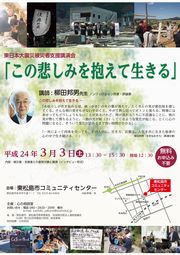
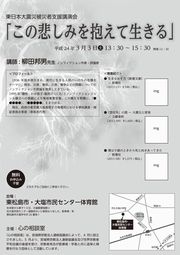
3rd, March. symposium "Kokoro no Kusuri" Flier table
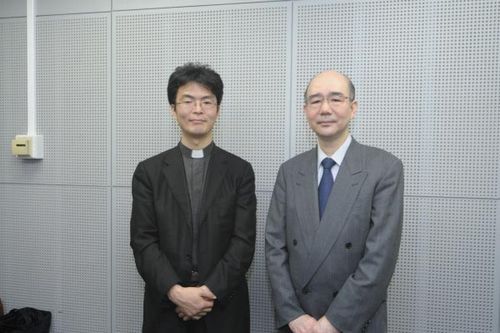
Kawakami and Director Kazuto Aida
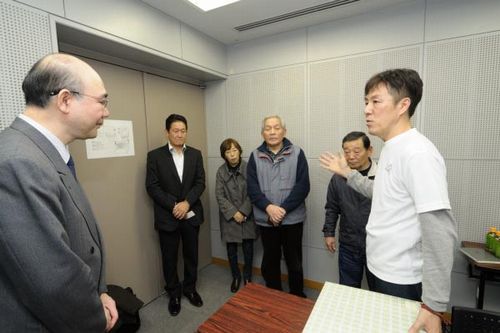
Senji Kurosu(Right). "Kokoro no Kusuri" symposium's director.
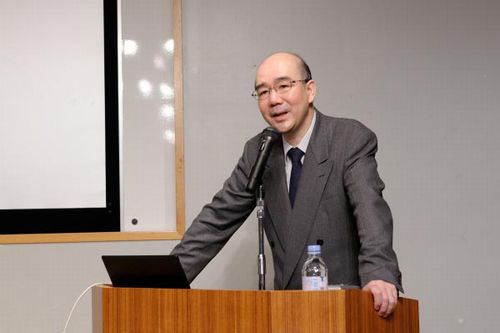
Director Kazuto Aida(Mitsuo Aida's son)
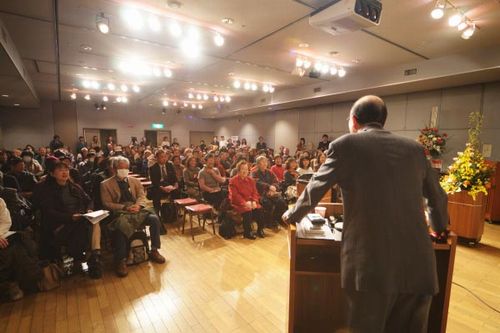
"Kokoro no Kusuri(Medicine of Heart)" symposium
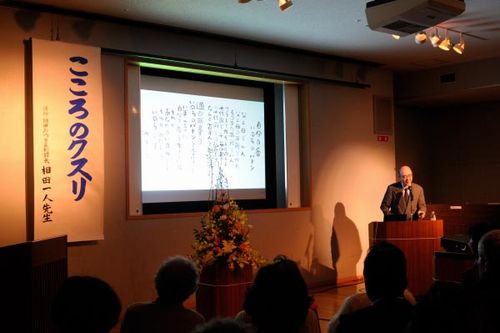
While watching the book of Mr. Mitsuo Aida(The most famous Japanese calligrapher)
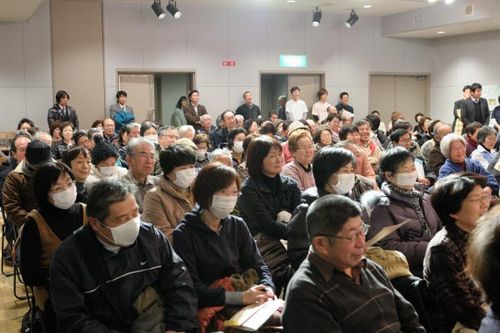
The venue

